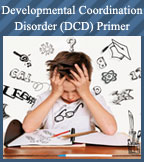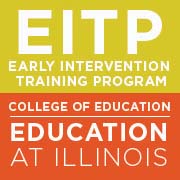Developmental coordination disorder (DCD), known as developmental dyspraxia in England, is a neurodevelopmental motor disorder that manifest as movements and coordination difficulties in fine motor (-which includes expressive speech), gross motor, motor planning, and coordination – diagnosed by the exclusion of all other causes of dyspraxia in otherwise normal children having normal to above normal intelligence. Enigmatic because of its heterogeneous presentation of several types of apraxia, the child with DCD is unable to translate conscious motor plans into motor plans resulting in limited and difficult motor activity. If not detected and addressed early in life, DCD can significantly interfere with functional skills, healthy emotional development, activities of dialing living, communication, &/or academic achievement. Suggested to be placed by some experts at the low end of the continuum of neuromotor disabilities - a minimal cerebral palsy, DCD is often more than just the lower end of normal variance in motor abilities.
What is it exactly? DCD may be part of a spectrum of several other specific learning, i.e., intellectual and developmental disabilities (IDD) and disorders of children including such as attention deficit hyperactivity disorder (ADHD), developmental verbal dyslexia (DVD), sensory processing disorder (SPD), and autism spectrum disorder (SPD). A common denominator to all these disorders has shown them to have in common white or grey matter abnormalities secondary to paucity or atypical organization of their sub-optimal structure, suggesting a biological marker as the etiologic origin of these variant conditions in what is deemed a neurodiversity. Indeed, many of the above disorders occur co-morbidly with DCD, and ADHD occurs in tandem with DCD approximately 50% of the time, suggesting a genetic link between both disorders.
Approximately 5–6% of children are affected by DCD, and some 25% of children with DCD will be referred prior to starting school, whereas the remaining 75% are referred during the first few years of primary school. Occupational therapists and pediatric neurologists play an important role is determining the type(s) of apraxia the child has, so that rehabilitation addressed the particular deficit the child exhibits. Educationally, because many have organizational difficulties, children with dyspraxia benefit from working in a structured environment.
By way of learning compensatory skills to overcome the more noxious causing disabilities associated with untreated DCD, these children - despite the setback of an inborn neurogenic motor disorder, may achieve the best possible chance for a successful life and positive view of themselves, despite their condition. The task-oriented approach to therapy is most helpful seeks compensate for this deficiency by imprinting motor engrams by repetition, and once accomplished, uses that success as a spring board to build confidence and learn the next motor activity.
This primer is a MUST READ for all early intervention and pre-school therapists who service the professional needs of the infant, toddler, and child with developmental coordination disorder!
Sign Up Now!

EITTOC is an AOTA Approved Provider of professional development. Course approval ID# 8922. This distance learning-independent is offered at 0.4 CEUs, introductory, OT service delivery/foundational knowledge. The assignment of AOTA CEUs does not imply endorsement of specific course content, products, or clinical procedures by AOTA or indicate AOTA approval of a certification or other professional recognition.
APPROVED BY THE ILLINOIS EARLY INTERVENTION TRAINING PROGRAM FOR EARLY INTERVENTION CREDENTIAL CREDIT for 3.0 Hours
Meets NY State (NYSOTA) Continuing Compliancy Requirements for continued Core Competency Hours (CCH)
Disclosure :David C Saidoff PT - course developer/presenter - has the following relevant financial relationships to disclose: he receives monetary compensation for the preparation of this course, in addition to a percentage of company sales, and has the following relevant non-financial relationships to disclose: EITTOC Board of Directors: volunteer member. Melissa Whelan, OTR - course developer/presenter - has the following relevant financial relationships to disclose: she receives monetary compensation for the preparation of this course, in addition to a percentage of company sales, and has the following relevant non-financial relationships to disclose: EITTOC Board of Directors Kristen O’Leary, SLP, has the following relevant financial relationships to disclose: she receives monetary compensation for the preparation of this course, in addition to a percentage of company sales, and has the following relevant non-financial relationships to disclose: EITTOC Board of Directors: volunteer member. EITTOC Board of Directors: volunteer member. EITTOC Board of Directors: volunteer member.Dr. Robert Koppel, M.D.,FAAP, Diplomate of the American Board of Pediatrics has the following relevant financial relationships to disclose: he receives monetary compensation for the preparation of this course, in addition to a percentage of company sales, and has the following relevant non-financial relationships to disclose: EITTOC Board of Directors: volunteer member. Declaration: Approval of this course does not necessarily imply that any of the governing bodies (e.g., West Virginian Board of Physical Therapy, or other such governmental or NGO’s supports the views of the presenter or sponsor. Information provided should be used within the scope of practice. No relevant financial or non-financial relationships exists between EITTOC or the products discussed any course; no such relationship or endorsement exists for any products mentioned in any courses sponsored by EITTOC, or in any of the items (such as specific AED or Epinephrine injection product) or any testing instrument used to evaluate children; the above course is specific to said-topic, and may not be extrapolated to any other course or topic outside the scope of this course. Course instructor(s) have no other financial or non-financial remuneration - whether prior to or following course delivery; the above advertisement is made available to all physical therapy (and other) licensee on a non-discriminatory basis. Ascend has approved this course and may be contacted about any concerns. Information provided should be used within scope of practice. AOTA does not endorse specific course content, products, or clinical procedures. The onus of responsibility for this course – granted contact hours by the AOTA – is for each OT professional to check with their State board of OT to see if this course meets licensure requirement for continuing education. AOTA does not endorse specific course content, products, or clinical procedures. |






